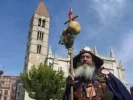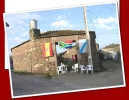sillydoll
Veteran Member
- Time of past OR future Camino
- 2002 CF: 2004 from Paris: 2006 VF: 2007 CF: 2009 Aragones, Ingles, Finisterre: 2011 X 2 on CF: 2013 'Caracoles': 2014 CF and Ingles 'Caracoles":2015 Logrono-Burgos (Hospitalero San Anton): 2016 La Douay to Aosta/San Gimignano to Rome:
Looking at my Credential stamps reminded me of some of the well known characters on the Camino Frances. If you are walking it for the first time, you might like some background on some of the special people you will meet along the way.
D Santiago Zubiri Elizade: This gregarious mayor of Larrasoana chats to each pilgrim and has a business card with “Amigo del Camino de Santiago” printed on it.
Felisia: The stamp reads, “Felisia – Higos-Aqua y Amor” (Figs, water and love.) Maria, Felisa’s daughter now sits at the rickety table outside a ramshackle farmhouse on the way to Logroño with a stamp pad to give sellos. On the table are two old dishes, one containing figs and the other for donations. Felisa died in October 2002 at the age of 92 but her stamp is still one of the most sought after on the camino.
Marcelino Lobato: One of the most photographed peregrinos in Spain, he walked his first Camino in the Holy Year of 1976 and was one of only 6 pilgrims who were issued with a Compostela that year. In the 1980’s he helped D Elias Valiña Sampedro to mark the camino with yellow arrows. This son of Rioja who has written 5 books on the camino, has walked over 130,000kms across France, Spain and Italy in his medieval robes, wide hat, staff and gourds. He has his ‘office’ on the edge of the La Grajera forest outside Logrono and greets pilgrims with offers of fruit, biscuits and walking sticks and a sign that says, no donations please. You will see a poster of him in his medieval robes in nearly every cafe bar on the camino.
Arturo: Hospitalero at Granon who runs the albergue, which is in the bell tower of a 16th C church, like an extended family, everyone chipping in to help cook and clean.
D. Jose Maria Alonso: The priest and San Juan de Ortega who might invite you to a meal of garlic soup and spiritual advice about the camino journey.
Tomás Martínez de Paz: aka Tomás-the-Templar. A quixotic character who was an ordinary middle-class citizen (albeit he had some history of being a subversive) living in Madrid with his family until about 25 years ago. Then one night he had a dream epiphany and left Madrid to build the pilgrim refuge at Manjarin on the Irago Mountain. He proclaims to be the last of the Knights Templars and is devoted to caring for pilgrims.
Jesus Jato: He and his family have been caring for pilgrims at Villafranca del Bierzo for 30 years. If you are lucky, you might be a part of his ‘queimada’ a ceremony that includes a flaming concoction of alcohol and honey, designed to protect pilgrims from thieves, blisters and other demons of the road.
D. Elias Vilas Sampedro: Died in 1990 but it is worth visiting his bronze bust in the church garden at O’Cebreiro. He was the priest who worked tirelessly to re-animate the almost forgotten camino and who painted the yellow arrows with paint scrounged from the roads department.
(If anyone else would like to add to this list, please do!)
D Santiago Zubiri Elizade: This gregarious mayor of Larrasoana chats to each pilgrim and has a business card with “Amigo del Camino de Santiago” printed on it.
Felisia: The stamp reads, “Felisia – Higos-Aqua y Amor” (Figs, water and love.) Maria, Felisa’s daughter now sits at the rickety table outside a ramshackle farmhouse on the way to Logroño with a stamp pad to give sellos. On the table are two old dishes, one containing figs and the other for donations. Felisa died in October 2002 at the age of 92 but her stamp is still one of the most sought after on the camino.
Marcelino Lobato: One of the most photographed peregrinos in Spain, he walked his first Camino in the Holy Year of 1976 and was one of only 6 pilgrims who were issued with a Compostela that year. In the 1980’s he helped D Elias Valiña Sampedro to mark the camino with yellow arrows. This son of Rioja who has written 5 books on the camino, has walked over 130,000kms across France, Spain and Italy in his medieval robes, wide hat, staff and gourds. He has his ‘office’ on the edge of the La Grajera forest outside Logrono and greets pilgrims with offers of fruit, biscuits and walking sticks and a sign that says, no donations please. You will see a poster of him in his medieval robes in nearly every cafe bar on the camino.
Arturo: Hospitalero at Granon who runs the albergue, which is in the bell tower of a 16th C church, like an extended family, everyone chipping in to help cook and clean.
D. Jose Maria Alonso: The priest and San Juan de Ortega who might invite you to a meal of garlic soup and spiritual advice about the camino journey.
Tomás Martínez de Paz: aka Tomás-the-Templar. A quixotic character who was an ordinary middle-class citizen (albeit he had some history of being a subversive) living in Madrid with his family until about 25 years ago. Then one night he had a dream epiphany and left Madrid to build the pilgrim refuge at Manjarin on the Irago Mountain. He proclaims to be the last of the Knights Templars and is devoted to caring for pilgrims.
Jesus Jato: He and his family have been caring for pilgrims at Villafranca del Bierzo for 30 years. If you are lucky, you might be a part of his ‘queimada’ a ceremony that includes a flaming concoction of alcohol and honey, designed to protect pilgrims from thieves, blisters and other demons of the road.
D. Elias Vilas Sampedro: Died in 1990 but it is worth visiting his bronze bust in the church garden at O’Cebreiro. He was the priest who worked tirelessly to re-animate the almost forgotten camino and who painted the yellow arrows with paint scrounged from the roads department.
(If anyone else would like to add to this list, please do!)
















